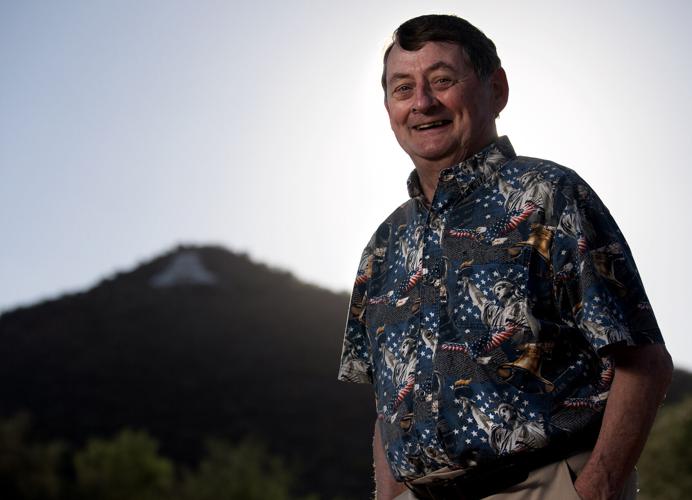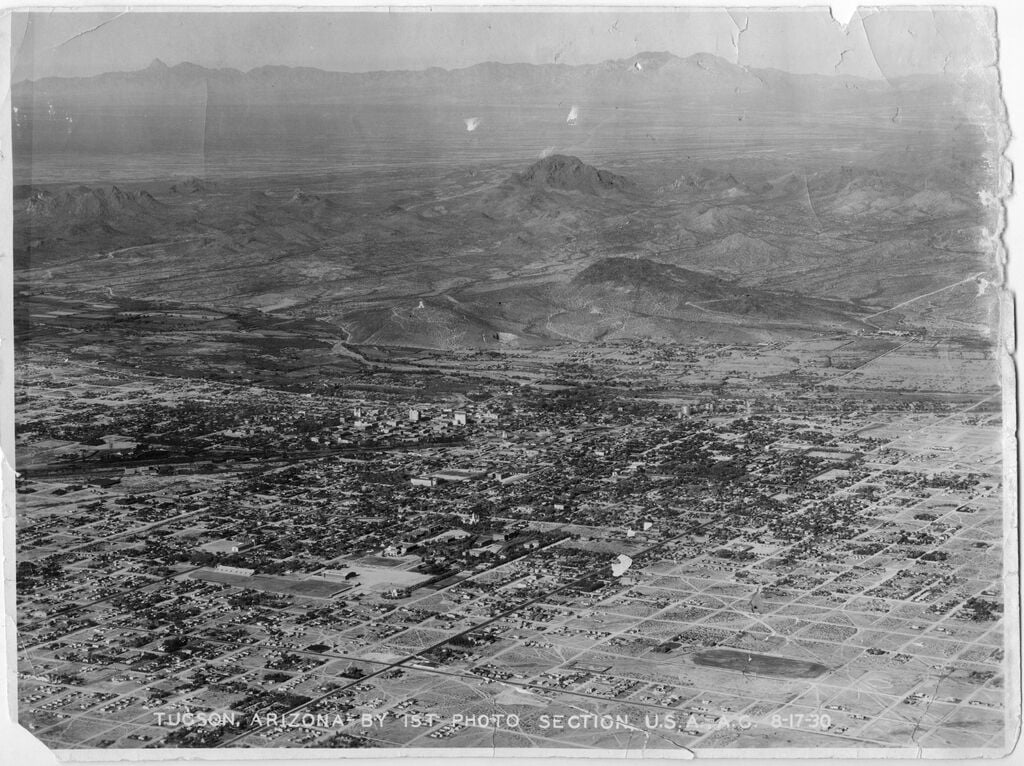When Sam O’Shaughnessy Stangl’s light-bulb moment hit in 1965, it actually involved about 300 light bulbs.
As a junior at the University of Arizona, O’Shaughnessy Stangl led his Delta Upsilon fraternity brothers on an ambitious quest to illuminate the “A” on “A” Mountain using about 700 feet of electrical cord and a 30,000-watt generator.

When Sam O’Shaughnessy Stangl was a junior at the University of Arizona, in 1965, he led his fraternity brothers on a mission to light up the “A” on Sentinel Peak, starting in the process a Homecoming tradition that continues today.
In the process, the future Tucson businessman helped launch a U of A homecoming tradition that continues today, albeit in somewhat different form.
On Sunday evening, students and alumni will light the block “A” in red using road flares to kick off homecoming week at the UA.
The fiery show will only last for a few minutes, whereas O’Shaughnessy Stangl’s lights stayed lit for five hours on Nov. 12 and again on Nov. 13, 1965.
“It was quite a feat,” the 77-year-old said. “30,000 watts is a lot of watts.”
He organized the light show as his pledge project for Delta Upsilon. He said the idea was inspired by an earlier experience on Sentinel Peak, when he helped paint the “A” and ended up covered in whitewash. It was the messiest college activity he ever participated in and one he had no interest in repeating, so he went looking for some other way to show his school spirit.
“Electricity was the most viable option,” he said.
It took about two months to measure the “A” and figure out what he would need to do the job.
His father was a general contractor, so O’Shaughnessy Stangl tapped the family’s connections in the local construction industry to find all the cord, light sockets and bulbs he needed. He used 3-foot concrete stakes, borrowed from several local subcontractors, to run the cord around the perimeter of the “A.”
It took him and three other guys a full day to drive the stakes, and another two days after that to install all 300 sockets and bulbs.
The generator was supplied by The Ashton Company, one of Arizona’s largest construction firms, which sent a worker up the mountain to flip on the power when the time came.
O’Shaughnessy Stangl said a few hundred people gathered for the show that first night, including his fraternity brothers and friends, curious onlookers, local authorities and someone from the newspaper.
“They did a countdown, we threw the switch, and that whole mountain lit up like you wouldn’t believe,” he said. “We got lucky.”
Though he was just 19 at the time, he’d had the presence of mind to call the Tucson Police Department in advance to let them know what he was up to. He said the department sent a couple of squad cars to provide some much-needed traffic control.
Tucson was less than half of its current size in 1965, but O’Shaughnessy Stangl said that “within an hour, there must have been a thousand cars lined up” on Sentinel Peak Road.
The only casualty of the night was the driver’s side door on his green 1962 Oldsmobile.
He said someone left the door open, and it was sheared off and sent tumbling down “A” Mountain by a passing motorist who may have been distracted – or possibly blinded – by the lights.
“I remember that like it was 10 minutes ago,” he said.
Fiery beginnings
The “A” on Sentinel Peak was first built by a group of university students in 1916, when Tucson was home to less than 20,000 people.
Marc Acuña, senior director for alumni and student engagement for the U of A, said the custom was simple back then: The upperclassmen would set fire to the “A” at the beginning of the school year and then welcome the freshmen class to campus by making them paint it white again.
According to Acuña, the practice of using electric lights on the “A” during homecoming appears to have died out sometime in the 1970s. He said students began illuminating it with flares in the 1980s, and that has been the homecoming tradition ever since.
Acuña said the annual lighting event usually draws a couple hundred people. The crowd sings “All Hail, Arizona” and “Bear Down Arizona,” and counts down to the moment when the flares are lit.
“This is a cool event because it involves all of Tucson,” he said.
They had to cancel the homecoming kickoff party in 2020 because of COVID. That year, they lit the “A” with LED lights, but it just didn’t have the same dramatic effect, Acuña said.
This year’s lighting event will be held from 5-7 p.m. Sunday at the MSA Annex at Avenida del Convento and Cushing Street.

Red flares light up the "A" on "A" Mountain in an undated photo. This year's lighting ceremony will be held starting at 5 p.m. Sunday to kick off the start of homecoming week at the U of A.
Acuña said the flares are arranged and lit by the 13 members of the Bobcats Senior Honorary, the university’s oldest student organization. The group, dedicated to protecting the heritage and traditions of the university, was formed after World War I in honor of the 13 U of A students who died in the war.
It takes about 250 flares to cover the entire “A.” “On a good day,” Acuña said, the flaming red glow will last for 5 to 10 minutes.
Not all business
O’Shaughnessy Stangl said he helped string lights around the “A” for homecoming twice more after that first time in 1965.
Then he and his new wife, Pipper, moved to Southern California, so he handed off the tradition – and all the electrical equipment – to the next group of college students.
The couple returned to Tucson a few years later, and O’Shaughnessy Stangl launched a successful career as a builder and entrepreneur, with several eastside developments and businesses to his credit.
He is probably best known for the string of bars he opened and regularly sang at, starting in the mid-1970s with O’Shaughnessy’s Piano Bar on Grant Road and Tucson Boulevard.
He also developed a reputation as a showman with a quirky, can-do sense of adventure.

Sam O'Shaughnessy Stangl, left, and a friend enjoy themselves in New Orleans in 1969, four years after the University of Arizona graduate used electric lights and a generator to light up "A" Mountain for homecoming.
Once in 1969, when he was working for IBM in Los Angeles, he and two tall friends from his office spent a wild night in New Orleans pretending to be members of UCLA’s national championship basketball team. They signed dozens of autographs for people on Bourbon Street until they drew the attention of some local TV sports reporters who wanted an on-camera interview.
In 1979, he bought the house in New York made famous by “The Amityville Horror.” The purchase made headlines, but he only got to walk around the supposedly haunted property once before he had to sell it to escape a tangle of lawsuits over who should profit from the popular book and movie of the same name.
In the mid 1980s, he and Pipper moved to Puerto Vallarta, Mexico, to run their beachside Señor O’Shaughnessys location and ended up with an African lion named Caesar as a pet for a couple of years.
And in 2009, he spent several thousand dollars to rescue a 9-foot-tall, 13-foot long sculpture of a bull from the shuttered Magic Carpet miniature golf course on Speedway. The one-ton bull, nicknamed Toro, stood outside O’Shaughnessy’s Song Hall and Supper Club near Tanque Verde and Kolb until the business closed in 2012.
O’Shaughnessy Stangl is mostly retired these days, though you can still occasionally find him “climbing trees with a chainsaw,” he said.
His specialty is sculpting large mesquites like the ones that grow along Tanque Verde Creek in his eastside neighborhood. On his business cards, he describes himself as a “cosmetic surgeon.”
O’Shaughnessy Stangl said he plans to attend this year’s “A” Mountain lighting ceremony. It will be the first one he’s gone to since the last time he helped light up “A” some 55 years ago.
“It’s time to do it,” he said, and so he will.








